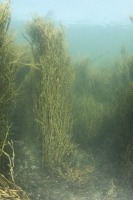
(Photo: Claire Goodwin)
Rockweed or Knotted Wrack
Ascophyllum nodosum
This seaweed is olive-brown. Several fronds grow from a holdfast that attaches onto rock. The fronds are thin and leathery, branched, and can be up to 2 metres long. They have large air bladders set at intervals down their length. These bladders let the fronds float up in the water column when the tide is in. When the tide is out, the seaweed lies over the ground.
Authority
Linnaeus Le Jolis, 1863
Classification Details
Phylum: Ochrophyta (brown multi and unicellular algae); Class: Phaeophyceae (brown seaweeds).
Habitat
Found throughout the north Atlantic. Attaches, using its holdfast, to rocky substrate in the mid to low intertidal. It is the dominant intertidal seaweed in Atlantic Canada.
Diet
Photosynthetic. Uses coloured compounds called pigments in its tissue to capture energy from sunlight. The major pigments used are chlorophyll a, chlorophyll c1 and c2, and fucoxanthin. The seaweed then uses the light energy is to turn water and carbon dioxide into sugar.
Reproduction
Separate sexes - each plant is either male or female. Plants hold eggs or sperm in receptacles on the sides of their fronds. They release them into the water and fertilization is external. The fertilized egg develops and settles on the seabed within 10 days. Individual fronds can last for up to 15 years but the holdfast at the base of the plant can live for several decades. Fronds can grow 10 to 20 centimetres per year.
Fun Facts
This species accounts for 50% of the primary productivity (energy produced from photosynthesis) in the Gulf of Maine.
People harvest rockweed commercially. They use it as a fertilizer, animal food supplement, and to produce sodium alginates which have many industrial uses.
If sea temperatures rise with climate change, this species could disappear from Canadian coasts.
References
Adey WH and Loveland K (2007) A Subarctic/Boreal Microcosm: Test of a Biogeographic Model in Dynamic Aquaria. Milton: Elsevier, pp. 371–404 DFO (1998) Rockweed in the Maritimes. Fisheries and Oceans Canada Science Stock Status Report, C3–57, 7pp. Dring MJ (1982) Marine Plants: taxonomic, morphological and ecological categories. In The Biology of Marine Plants. London: Edward Arnold. pp 1–12. Guiry MD (2020) Ascophyllum nodosum. In: Guiry MD & Guiry GM (eds) AlgaeBase. World-wide electronic publication, National University of Ireland, Galway. https://www.algaebase.org/search/species/detail/?species_id=5 Accessed 19 January 2020. Khan AH, Levac E, Van Guelphen L, Pohle G, and Chmura GL (2018) The effect of global climate change on the future distribution of economically important macroalgae (seaweeds) in the northwest Atlantic. FACETS 3, 275–286. Hill JM and White N (2008) Ascophyllum nodosum Knotted wrack. In Tyler-Walters H and Hiscock K (eds) Marine Life Information Network: Biology and Sensitivity Key Information Reviews [on–line]. Plymouth: Marine Biological Association of the United Kingdom. Available from: https://www.marlin.ac.uk/species/detail/1336 Accessed 19 January 2020. Schmidt AL, Coll M, Romanuk TN, Lotze HK (2011) Ecosystem structure and services in eelgrass Zostera marina and rockweed Ascophyllum nodosum habitats. Marine Ecology Progress Series 437, 51–68. Sharp GJ and Semple RE (1997) Rockweed (Ascophyllum nodosum). Department of Fisheries and Oceans – Invertebrate Fisheries Division. 10 pp. Smithsonian Science Education Centre. What is Photosynthesis. STEMvisions Blog. https://ssec.si.edu/stemvisions-blog/what-photosynthesis Accessed 19 January 2020.

